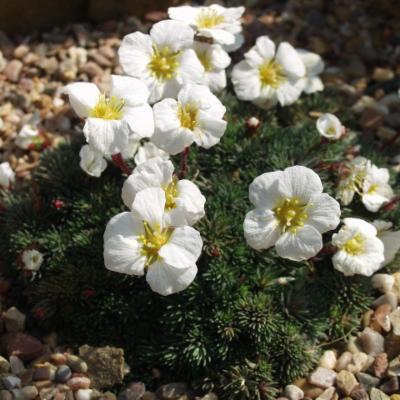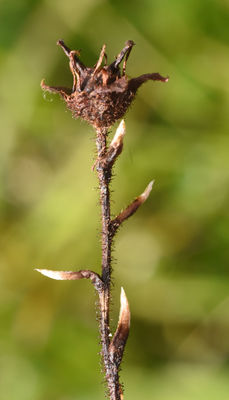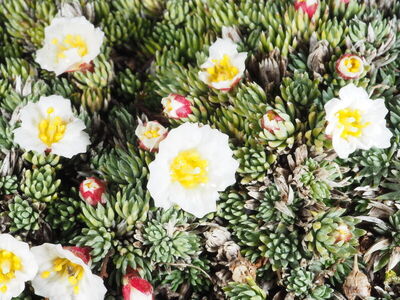-
General Description
-
Most saxifrage species are associated with spring and early summer, but the flowers of Burser's saxifrage can be produced amid the snow, and during the bleak and dull weather of mid-winter.
Saxifraga burseriana (sometimes mis-spelt S. burserana) belongs to a popular group of species known as the 'Kabschia' saxifrages, one of the 15 groups into which botanists have divided the saxifrage species. The name 'Kabschia' commemorates a German botanist, Wilhelm Kabsch (1835-1864), who unfortunately tumbled off a cliff while studying phytogeography in the Alps.
Saxifraga burseriana was described by Linnaeus in 1753 and is named after Joachim Burser (1583-1649), a German physician and botanist whose herbarium was studied by Linnaeus.
Reginald Farrer, the author of The English Rock Garden, published in 1918, described Saxifraga burseriana as 'the loveliest of the kabschias, forming a mat a foot across, dense with thick and spiny glaucous [with a waxy bloom] -blue leaves, from which arise in February and March red stems of an inch or two, bearing each a single enormous pure-white flower, wide open, solid and splendid'.
-
Species Profile
-
Geography and distribution
Found in the Eastern Alps. Its range is split in two; in the north it occurs in Austria and the Bavarian Alps and to the south in northern Italy, southern Austria and Slovenia.
It usually grows at altitudes of 1,500-2,200 m but can be found as low as 230 m in the valley of the Adige and has been recorded as high as 2,500 m.
The plant painted for Curtis's Botanical Magazine was collected at 1,500 m in the Julian Alps by Brian Mathew, in June 1975.
Description
Saxifraga burseriana has solitary (occasionally twinned) white flowers, held on reddish stems above a compact mound of narrow, fleshy, glaucous (with a waxy bloom) leaves.
The leaves of this species are around 1 cm long, and narrowly lanceolate (narrow and tapering to a point), tapering to a stiff pointed tip and with 5-7 hydathodes (water glands) on their upper surface. The red, minutely hairy, flower stems can reach 5 cm tall and have a few stem leaves.
This is one of the most beautiful Kabschia saxifrages and David Webb writes in Curtis's Botanical Magazine : 'Within this section there are few species that can challenge and none that clearly surpass S. burseriana in beauty. The neat blue-grey foliage, the bright red peduncles (flower stalk) and the large, snowy-white flowers combine to form a colour-scheme which is very striking, and yet with a touch of puritan restraint'.
Uses
Saxifraga burseriana is cultivated as an ornamental.
Cultivation
As with other Kabschia saxifrages, S. burseriana likes plenty of moisture from early spring to summer, when in full growth. In cultivation it can flower as early as February and March, and the period after flowering is when most growth takes place. In the winter little water is needed but it should not be allowed to dry out completely. In a rock garden this species can be grown in a free-draining scree but will almost certainly require some watering in summer.
Whether grown in a pot, a trough or out in the open garden, Kabschia saxifrages require the maximum possible light in winter but in summer they need some shade. Too much hot summer sun will lead to scorching of the leaves, causing portions of the cushion to die away. Conversely, too much shade may result in poor flowering.
Saxifraga burseriana is not a variable species and cultivars, such as 'Gloria' and 'Brookside', were distinguished mainly on the basis of variation in flower size and petal shape. No natural hybrids are known but there are numerous artificial hybrids involving this species crossed with others in the same section.
This species at Kew
Saxifraga burseriana can be seen in the Alpine House at Kew when in flower.
Besides dried material, spirit-preserved specimens of Saxifraga burseriana are held in Kew's Herbarium, where they are available to researchers, by appointment. The details of one of these can be seen online in the Herbarium Catalogue.
-
Distribution
-
Austria
-
Ecology
-
On calcareous rocks, sometimes in crevices but usually on screes or disintegrating rocky surfaces.
-
Conservation
-
Not Evaluated according to IUCN Red List criteria, however, a related species,
Saxifraga tombeanensis, from the Italian Alps has been listed as Endangered.
-
Hazards
-
None known.










